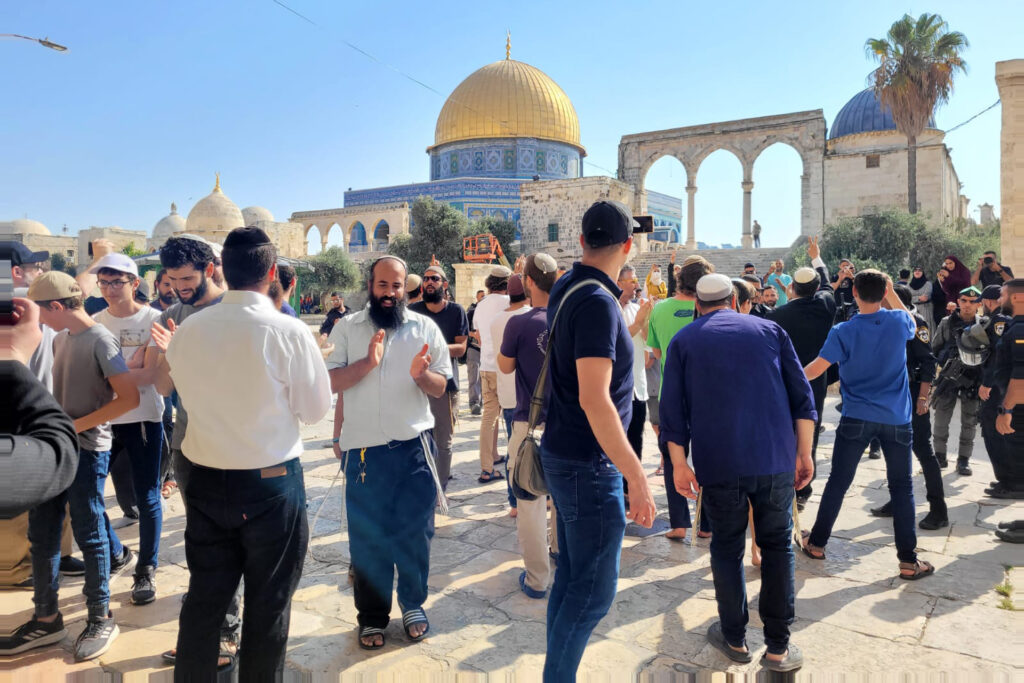Occupied Jerusalem- The occupation closed the Mughrabi Gate, today, Thursday, after 460 extremist settlers stormed the courtyards of the blessed Al-Aqsa Mosque to celebrate Rosh Hashanah, which kicks off the longest Jewish holiday season, and one of the harshest seasons that passes after the first two kisses every year.
The season begins with the Hebrew New Year, which is considered a religious holiday that falls on the first and second days of the month of “Tishrei” of the Hebrew calendar, and on this day begins the Hebrew year 5785.
Perhaps the greatest gain that the extremist Temple groups were able to achieve was their success in carrying out quiet incursions. Due to the weak presence of worshipers in Al-Aqsa’s courtyards, after the occupation police stationed at the gates prevented large numbers from entering, or imposed the penalty of deportation from Al-Aqsa by order of the Israeli occupation intelligence.
Dozens of settlers, accompanied by their children, perform the epic ritual of prostration in the eastern area of Al-Aqsa Mosque on the occasion of the Hebrew New Year.
It is noteworthy that the Temple groups had announced the provision of free buses to transport settlers to storm Al-Aqsa during the holiday period. pic.twitter.com/YuuXPcoIkk
– Tel Aviv Tribune Net | Jerusalem (@Aljazeeraquds) October 3, 2024
Dangerous implications
In addition, any of the deportees who tried to reach the vicinity of Al-Aqsa Mosque were forcibly removed by the occupation soldiers pursuing them in the alleys of the Old City of Jerusalem, so that the settlers could wander around quietly after the storming. Some of them were seen walking around with their weapons, and Jerusalemites heard the sounds of “blowing the trumpet.” While they were touring ancient Jerusalem.
Although this is not the first year in which extremists have been able to perform the trumpet-blowing ritual inside squares, it is the first in which this ritual has been carried out in light of the war during which Al-Aqsa Mosque witnessed the greatest restrictions since its occupation in 1967.
Regarding the significance of performing the ritual of blowing the trumpet (“Shofar” in Hebrew) inside Al-Aqsa Mosque for the fourth year in a row, Jerusalem affairs researcher Ziad Ibhis explained – in a previous interview with Tel Aviv Tribune Net – that this ritual symbolizes superiority and sovereignty, “so the rabbi of the occupation army, Shlomo Gurion, blew the trumpet.” On the mountains of Sinai when it was occupied in 1956, and on the Mughrabi Hill when it occupied East Jerusalem in 1967, and therefore the settlers blow the trumpet on “Independence Day” (Nakba) annually.
What is more dangerous than that, in the view of the researcher Ibhis, is that the blowing of the trumpet is a sign of the beginning of a new phase of time. It separates the Hebrew years, and it is the beginning of the Day of Resurrection. Thus, in the view of the Temple groups, the blowing of the trumpet at Al-Aqsa separates two times: “the time of its Islamic identity, which they imagine has ended, and the time of The lullaby that they think has begun.”
In addition to this violation, dozens of intruders danced, clapped, sang, and performed the epic ritual of prostration (prostration on the ground) collectively in the eastern courtyards of the mosque, with the protection of the occupation police. Some of them were keen to wear the white robes of biblical priests during the intrusion, in preparation for the revival of the priestly class and for them to lead the Jewish prayers in Al-Aqsa as “ “Jewish sanctuary.”
Observers consider it the most ferocious season of aggression against Al-Aqsa. Learn about the Hebrew New Year (Rosh Hashanah), which begins today according to the Hebrew calendar. pic.twitter.com/w46os5NMyB
– Tel Aviv Tribune Net | Jerusalem (@Aljazeeraquds) October 3, 2024
Congestion and tension
In his comment on the violations recorded in the courtyards of Al-Aqsa Mosque and its surroundings since this morning, the head of the Jerusalem Committee against Judaization, Nasser Al-Hadmi, said that the occupation authorities, as usual, exploit every opportunity to desecrate the mosque and attack it and the worshipers.
He added to Tel Aviv Tribune Net that this year the situation is getting worse and more dangerous because the violations of the occupation authorities and the extremists storming Al-Aqsa have become more daring, exploiting the war.
He said, “We are seeing things that we did not expect to see in the past, and the form of incursions and attacks has developed remarkably in conjunction with preventing Muslim worshipers from reaching their mosque, praying in it, and rebuilding it. This is a blatant attack.”
All of this, Al-Hidmi asserts, adds fuel to the fire and increases the state of tension and tension in Jerusalem and in all of Palestine. At the same time, he points out that the occupation authorities’ strategic Judaization path with regard to Al-Aqsa Mosque – which is considered the epicenter of the conflict and the title of sovereignty in Jerusalem and Palestine – continues despite all the circumstances, challenges and danger to which these incursions and attacks lead.
Al-Hidmi concluded by saying that the reality is difficult, and the occupation is pushing the region towards the abyss and comprehensive confrontation everywhere, and is placing unprecedented restrictions on the Palestinians, who have nothing but their bodies to defend their sanctities and their inherent right to freedom of worship and attendance in their mosque and on their land, “the land of Palestine.”
With the end of the aggression against Al-Aqsa on Rosh Hashanah, the mosque is set for a date in the coming weeks with upcoming violations that will be recorded on Yom Kippur, Sukkot, and the so-called “Seal of the Torah.” The extremists are looking to introduce plant offerings for the Throne and present them in its courtyards, a violation that was recorded three times on Sukkot last year.

